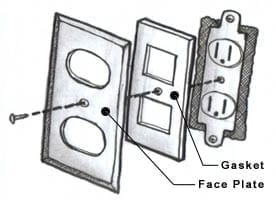Being the ‘frugal’ homeowner of a historic house, I’m always looking for ways to save money on my energy bills and to be more environmentally responsible. With that in mind, I thought I’d share my top five inexpensive ways to ‘green’ an existing home:
- First on the list of energy savings is to seal your home’s envelope. The ‘envelope’ in this case means the perimeter of the house where the insulation is located. Imagine a box with lots of holes in it; the intent of sealing the house is to minimize the infiltration of unwanted exterior air or the loss of interior conditioned air. Simple, inexpensive ideas: Install weather-stripping at doors and windows. Make sure all glazing in the windows is intact (especially in an older home.) Install gaskets at all electrical outlets and switches in exterior walls. Inspect all insulation in the attic and in the crawlspace and make sure there are no gaps between the blankets. Install additional insulation to meet or exceed your local area’s Code requirements. Use a can of spray foam insulation to seal all plumbing and electrical penetrations from the attic or crawlspace into the living space. Use this same spray foam insulation to seal around all ductwork boots, junction boxes at ceiling lights, bath fan boxes, etc.
- The heating and air conditioning system is usually the source for the biggest energy loss in a home, where sometimes up to 30-40% of conditioned air is lost through leaks in the ductwork. Inspect the flexible ductwork and make sure there are no tears in the wrap; if so, replace it (the newer ductwork is better insulated anyway.) Often, the connection at either end of the flexible duct is not properly attached to the hard duct or the distribution boot; if it’s loose or disconnected, use a duct strap to make the secure attachment. At hard ductwork and distribution boots, use brush applied mastic to seal all the seams. It is also very important to make sure the air conditioning system is properly charged so that it runs at top efficiency. Lastly, use high quality filters and replace frequently.
- Concerning the electrical system, one way to save money on energy costs is to replace incandescent light bulbs with long lasting and efficient compact fluorescent lamps (CFLs.) There are now CFLs in a variety of color spectrums and even dimmable lamps. Ceiling fans are another way to cut down on cooling costs, as thermostats can be set higher because the air movement makes you feel cooler.
- There are plenty of opportunities in your water system to save money and reduce the impact on the environment. Replace the faucets in your sinks and lavatories and your shower heads with low flow fixtures. If you need (or want) to replace your toilet, at the minimum install WaterSense toilets but also consider dual flush models. Lastly, don’t forget to insulate all hot water piping.
- Finally, decisions made outside your home can also have a dramatic impact on ‘greening’ your home. Planting deciduous shade trees on the south and west side of your home can have a long term impact on cooling costs during the summer, while allowing exposure to the winter sun. In your landscaping, install drought-tolerant plants and turf as a way to minimize watering needs. Capture rainwater in rain barrels for those times you do need to water.
These are all very simple and inexpensive ways to save money on your energy and water bills, easily done by the homeowner without hiring expensive tradesmen, and with parts and materials readily available at your local hardware store. Each may seem insignificant, but together they can make a huge impact. Good luck!
– David Maurer, AIA, LEED AP
President, TightLines Designs

